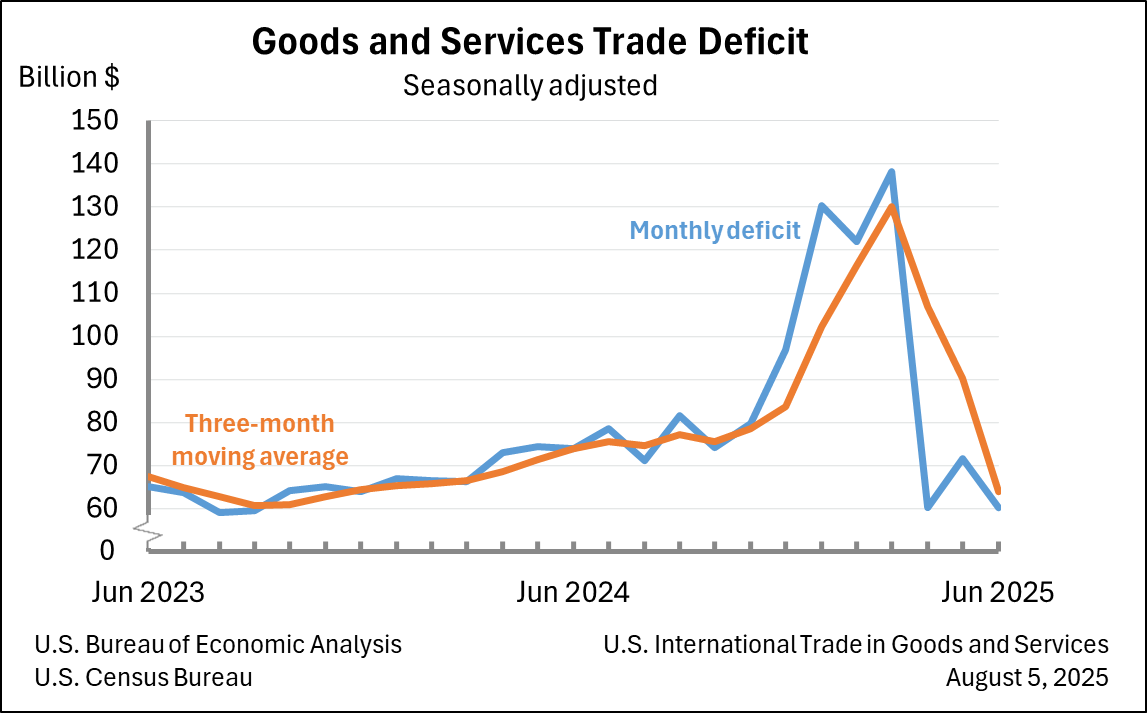Bureau of Economic Analysis
U.S. International Trade in Goods and Services, June 2025
The U.S. goods and services trade deficit decreased in June 2025 according to the U.S. Bureau of Economic Analysis and the U.S. Census Bureau. The deficit decreased from $71.7 billion in May (revised) to $60.2 billion in June, as exports decreased less than imports. The goods deficit decreased $11.4 billion in June to $85.9 billion. The services surplus increased $0.1 billion in June to $25.7 billion.
Principal Federal Economic Indicators
Noteworthy
- 2025 News Release Schedule
- Innovation at BEA
- 2025 Annual Updates
- New! Services Trade Data for More Countries
- Data Tool: Trade in Value Added
- Distribution of State Personal Income
- Updated: RIMS II Regional Multipliers
- Arts and Culture
- Space Economy
- FDI Now in State BEARFACTS
- Quick Guide: Price Indexes
The Latest
Consumer Spending on Durable Goods Rises in June
Personal income increased 0.2 percent in June, the same increase as in May. Wages and salaries, the largest component of personal income, increased 0.3 percent in June after increasing 0.2 percent in May.
Personal Income and Outlays, June 2016
Personal income increased $29.3 billion (0.2 percent) in June according to estimates released today by the Bureau of Economic Analysis. Disposable personal income (DPI) increased $24.6 billion (0.2 percent) and personal consumption expenditures (PCE) increased $53.0 billion (0.4 percent). Real DPI increased 0.1 percent in June and Real PCE increased 0.3 percent. The PCE price index increased 0.1 percent.
GDP Update Finds Little Change in Economic Picture of Last 3 Years
The Bureau of Economic Analysis released its annual update of GDP and related statistics today, adjusting its picture of U.S. economic activity during the past three years to reflect newly available data.
GDP Increases in Second Quarter
Real gross domestic product (GDP) increased 1.2 percent in the second quarter of 2016, according to the “advance” estimate released by the Bureau of Economic Analysis. In the first quarter, real GDP increased 0.8 percent (revised).
Gross Domestic Product, 2nd quarter 2016 (advance estimate)
Real gross domestic product increased at an annual rate of 1.2 percent in the second quarter of 2016 (table 1), according to the "advance" estimate released by the Bureau of Economic Analysis. In the first quarter, real GDP increased 0.8 percent (revised). The Bureau emphasized that the second-quarter advance estimate released today is based on source data that are incomplete or subject to further revision by the source agency (see “Source…
Gross Domestic Product by State: First Quarter 2016
Real gross domestic product (GDP) increased in 37 states and the District of Columbia in the first quarter of 2016, according to statistics on the geographic breakout of GDP released today by the Bureau of Economic Analysis. Real GDP by state growth, at an annual rate, ranged from 3.9 percent in Arkansas to –11.4 percent in North Dakota. Construction; health care and social assistance; and retail trade were…
Gross Domestic Product by State, 1st quarter 2016
Real gross domestic product (GDP) increased in 37 states and the District of Columbia in the first quarter of 2016, according to statistics on the geographic breakout of GDP released today by the Bureau of Economic Analysis. Real GDP by state growth, at an annual rate, ranged from 3.9 percent in Arkansas to -11.4 percent in North Dakota. Construction; health care and social assistance; and retail trade were the leading contributors to U.S.…
Detailed Direct Investment Data for 2015 Now Available
Detailed statistics on U.S. direct investment abroad – or “outward direct investment”– and on foreign direct investment in the United States – or “inward direct investment” – are now available on BEA’s website.
BEA Announces Selection of New Deputy Director
Sarahelen “Sally” Thompson will become the Bureau of Economic Analysis’ new Deputy Director, starting on July 24.
Industry in Focus: Construction on the Rise
Although the U.S. economy has changed considerably over time, construction is an industry that’s maintained its importance. We no longer depend on telegraphs as we once did, but we’ll always need a place to live. Construction also is an industry in which the products can differ to a great degree. While cellphones may be quite similar to one another, office buildings take shapes ranging from the Empire State Building to a one-story structure…




